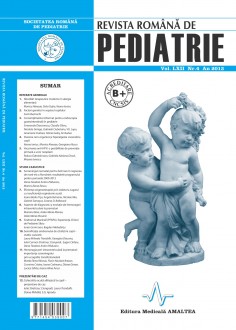SELECT ISSUE

Indexed

| |

|
|
|
| |
|
|
|

|
|
|
|
|
|
|
HIGHLIGHTS
National Awards “Science and Research”
NEW! RJP has announced the annually National Award for "Science and Research" for the best scientific articles published throughout the year in the official journal.
Read the Recommendations for the Conduct, Reporting, Editing, and Publication of Scholarly work in Medical Journals.
The published medical research literature is a global public good. Medical journal editors have a social responsibility to promote global health by publishing, whenever possible, research that furthers health worldwide.
NONORGANIC PAIN AND VISCERAL HYPERALGESIA IN CHILDHOOD
Ileana Ioniuc, Monica Alexoae and Georgiana Russu
ABSTRACT
Visceral pain is different from the somatic one: visceral receptors have different functional engagement, the nociception degree differ from one organ to another, the few visceral afferent fibers are predominantly unmyelinised and have an extensive divergence in the central nervous system; the responses involve autonomic activation. The matrix of abdominal visceral pain, functional at birth, is overburdened by mechanical, chemical, osmotic impulses; overlapping infections or inflammation, by the released mediators create the conditions for acquiring the peripheral and central “sensibility” and the “pain memory”; behavioral and emotional factors can aggravate the visceral pain matrix hyperreactivity. In this pathogenic context it defines nonorganic pain and its severe form, visceral hyperalgesia. Genetic peculiarities influence the pain sensitivity. Based on the biopsychosocial model of functional disorders, Rome III criteria tagged the abdominal functional pain and the irritable bowel syndrome as a positive diagnosis and not a diagnosis of exclusion. Nonorganic pain, often associated with recurrent abdominal pain is among the most common medical problems encountered in pediatrics. Most patients with mild pain have a good evolution over time; a small percentage present serious and sometimes disabling symptoms. Pediatricians frequently have difficulties in delineation the diagnosis of nonorganic pain and that, sometimes, involves treatment failure. The authors present the epidemiological data, the pathophysiological mechanisms involved, the clinical approach and the therapeutic options on nonorganic pain and visceral hyperalgesia in children.
Key words: functional abdominal pain, visceral hyperalgesia, child
